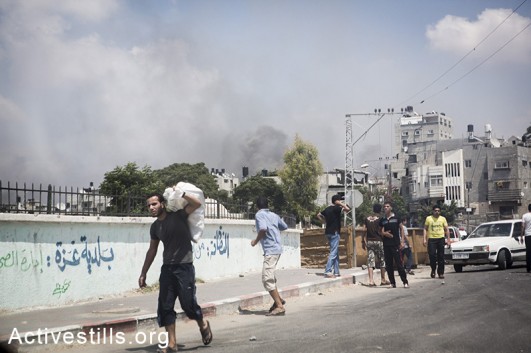“Thank you for asking about us,” he says. “It seems the rest of the world only cares when the bombs are falling.”
His name means “struggle.” From his apartment window in Gaza City, Jehad films the flames consuming flesh. As we speak, concussive boom-after-boom carries his voice to a shrill, and we are both short of breath.
I try to change the subject. “Remember the orange trees, Jehad?” But this, too, is on-topic. The trees came from Shejaiya, the neighborhood now framed by Jehad’s lens. He is live streaming, and the news can’t catch up with the scene – five minutes since the medic was hit, seven minutes since the family died together. Yesterday, 60 people felled by the shelling.

Together, we remember: There, where the slate plumes swirl, Jehad and his friends once planted saplings.
It was January, seven months before the horror now reeling. They met – 300 of them – at the traffic circle in the heart of Shejaiya. From there, they marched east towards the turrets, to where Odeh was killed.
In search of something – anything – to sell, Odeh wandered on fallow farmland, collecting scrap metal with his brother. One day he wandered too far into the “buffer zone” and an Israeli sniper killed him.
When they went there in protest, the 300 went unarmed, carrying orange trees – and mirrors. The mirrors they held up to the soldiers so they might see themselves through their scopes; so they might think twice before shooting.
They didn’t.

Jehad filmed that day, too, as he had before in Israel’s “death zone.” And each time he did, we sent the footage to journalists, inviting them to “meet Gaza’s non-violent resistance.” We pled with them to cover the story, to expose the killing before the murders turned to massacres.
They didn’t.
Now it’s too late. As one journalist wrote recently, Gaza is not counting the dead anymore. It is counting the massacres. But it didn’t have to be this way.
Had they bothered to see for themselves, American journalists would have noticed: Gaza’s earth was parched long before Israel took a match to it. They would have noticed that well before the current “war,” nearly half of Gaza’s arable land was off-limits to Palestinians, consumed by Israel’s unilaterally imposed buffer zone. Or that Palestinians were being shot a kilometer and a half from their border by Israeli snipers. That’s about a mile, in a place that, at its girth, is seven miles wide.

Today, the buffer zone is getting wider. More than 100,000 Palestinians, many of them already refugees from Israel’s creation, have been forced from its margins, seeking shelter where there is none. The bombs fall everywhere. And Jehad just felt one. I hear it, and we change the subject again.
I met Jehad after the November 2012 war, when he and his then-fiancée were planning their wedding. I ask if they’re contemplating children. He sounds puzzled. “Why would we want to bring children into this?”
“This” hovers over everything in Gaza. Over Jehad’s voice, I hear the low hum of a drone.“This war will leave fewer orphans,” writes a Palestinian doctor near Shejaiya. Because “this war takes whole families.”
As he watches the carnage from his window, Jehad – whose name means “struggle” – bids me farewell. “Thank you for asking about us,” he says. “It seems the rest of the world only cares when the bombs are falling.”
Related:
Why do Palestinians continues to support Hamas despite such devastating losses?
Gaza war diary: ‘A second of silence then the bombs go off’
Gaza ground invasion: Shedding the pretense of ‘precision’

